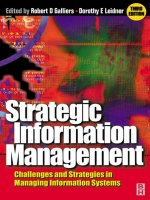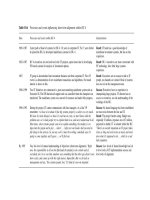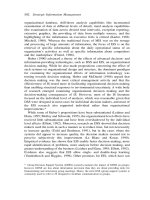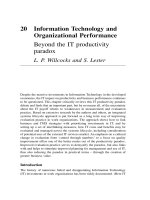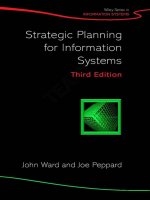Managing information systems 7th edition brow ch012
Bạn đang xem bản rút gọn của tài liệu. Xem và tải ngay bản đầy đủ của tài liệu tại đây (817.51 KB, 29 trang )
MANAGEMENT INFORMATION SYSTEMS
CHAPTER 12
PLANNING INFORMATION SYSTEM RESOURCES
Copyright © 2011 Pearson Education, Inc. publishing as Prentice Hall
12-1
PLANNING INFORMATION SYSTEMS RESOURCES
•
IS and business managers need to work together to guide their organization in the planning and management of
IS resources
- Chapter 12: Steps for effective IS resource planning to best position the IS organization to enable current and
future business goals
- Chapter 13: Roles, responsibilities, and some “best practices” for leading an IS organization
Copyright © 2011 Pearson Education, Inc. publishing as Prentice Hall
12-2
BENEFITS OF INFORMATION RESOURCES PLANNING
•
Creating a context for IS resource decision-making
•
Aligning IS and business goals
•
Balancing the tradeoffs between standardization and agility
•
Obtaining IT capital investment approvals
This requires both a periodic strategic planning process, as well as an ongoing monitoring of the appropriateness of
IS plans in response to changes in the business and its environment.
Copyright © 2011 Pearson Education, Inc. publishing as Prentice Hall
12-3
MULTI-STEP PLANNING PROCESS
( from an Enterprise perspective)
1.
Assessment of current Information resources (the status quo)
2.
Establishment of an Information Vision
3.
Establishment of an IT Architecture for that vision
4.
Formulation of an IS Strategic Plan (roadmap) to evolve an organization’s information resources from their current
status toward the desired vision and IT architecture
5.
Formulation of short-term Operational IS Plans based on the IS Strategic Plan
Copyright © 2011 Pearson Education, Inc. publishing as Prentice Hall
12-4
ALIGNING BUSINESS AND IS PLANNING
•
IS decisions should be tightly aligned with the direction
of the business
•
IS steps ideally impact the next step in the business
planning process, but in practice this is not
yet typically found
Fig 12.1 The Information Resources Planning Process
Copyright © 2011 Pearson Education, Inc. publishing as Prentice Hall
12-5
ASSESSING CURRENT INFORMATION RESOURCES
Inventorying and critically evaluating an organization’s technical and human resources in terms of how well they
are meeting the organization’s business needs
•
Current performance is compared to a previous plan, competitors,
or a set of past objectives
•
Comparisons are made using:
- Operational data (usage of IS resources)
- Survey of client satisfaction with IS performance
- Benchmarks of what is being achieved at other organizations
Copyright © 2011 Pearson Education, Inc. publishing as Prentice Hall
12-6
INFORMATION RESOURCES ASSESMENT:
Examples of Assessment Statements
Copyright © 2011 Pearson Education, Inc. publishing as Prentice Hall
12-7
ASSESSING CURRENT INFORMATION RESOURCES
Assessing IS Performance
•
Example: comparing actual performance to goals
Copyright © 2011 Pearson Education, Inc. publishing as Prentice Hall
12-8
ASSESSING CURRENT INFORMATION RESOURCES
Measuring Attitudes of Users
•
IT managers should also consider assessing the attitudes of users about the performance of the IS
organization in relation to the current needs & future direction of the business
Copyright © 2011 Pearson Education, Inc. publishing as Prentice Hall
12-9
ASSESSING CURRENT INFORMATION RESOURCES
IS Organizational Mission Statement
•
Sets forth the fundamental rationale (or reason to exist) for activities of the IS organization
•
Can vary substantially from one organization to another because some IS departments play more “support”
roles than “strategic” roles
•
The extent to which the IS organization plays a strategic role can be measured by:
–
–
the degree to which the organization is dependent on IT for business operations
the degree to which IT is enabling the current business strategy
Copyright © 2011 Pearson Education, Inc. publishing as Prentice Hall
12-10
ASSESSING CURRENT INFORMATION RESOURCES
Assessing the IS Mission involves reconciling any differences between IS manager and business manager
views
Copyright © 2011 Pearson Education, Inc. publishing as Prentice Hall
12-11
CREATING AN INFORMATION VISION
Information Vision
A written expression of the desired future about how information will be used and managed in the
organization
- Specific enough to guide policy decisions
Developing a vision requires both an understanding of the future direction of the business and an understanding of
the role information can best play in enabling that future business strategy
- Focus is on the long term
Copyright © 2011 Pearson Education, Inc. publishing as Prentice Hall
12-12
DESIGNING THE IT ARCHITECTURE
Information Technology Architecture
•
•
Depicts the way an organization’s information resources will be deployed to deliver its vision
Specifies how the Technological and Human assets of the IS organization will be deployed in the future to
meet the information vision
.
Copyright © 2011 Pearson Education, Inc. publishing as Prentice Hall
12-13
DESIGNING THE IT ARCHITECTURE
Four Stages of IT Architecture Maturity (Ross, 2003):
1.
2.
Application Silos – companies seek to maximize individual business unit or functional needs
Standardized Technology – companies seek to enable IT efficiencies through shared services and application
rationalization, resulting in enterprise-wide IT standardization
3.
Rationalized Data – companies implement enterprise-wide business processes and data with tightly linked systems and
processes (such as with ERP systems)
4.
Modular – companies seek global flexibility with loosely coupled IT-enabled business process components, which
enable local differences but also preserve enterprise-wide standards
Copyright © 2011 Pearson Education, Inc. publishing as Prentice Hall
12-14
4 STAGES OF ARCHITECTURE MATURITY
Fig 12.5 Changing Resource Allocation across Architecture stages, Ross 2003
Copyright © 2011 Pearson Education, Inc. publishing as Prentice Hall
12-15
IT CAPABILITIES AND BUSINESS METRICS FOR
IT ARCHITECTURE STAGES
Figure 12.6 IT Capabilities and Business Metrics for 4 IT Architecture Stages (Based on Ross, 2003)
Copyright © 2011 Pearson Education, Inc. publishing as Prentice Hall
12-16
FORMULATING THE STRATEGIC IS PLAN
Strategic IS Plan
Long-term objectives (often three to five years) that represent measurable movement toward the Information
Vision and IT Architecture
and
Major initiatives that must be undertaken to achieve these objectives
Copyright © 2011 Pearson Education, Inc. publishing as Prentice Hall
12-17
FORMULATING THE STRATEGIC IS PLAN
4 Steps in Strategic IS Planning Process
1.
Setting objectives
2.
Conducting an external analysis
3.
Conducting an internal analysis
4.
Establishing strategic initiatives
Most planning processes involve iterations through these 4 steps
Copyright © 2011 Pearson Education, Inc. publishing as Prentice Hall
12-18
FORMULATING THE STRATEGIC IS PLAN
1.
Setting objectives
–
Measures are identified for each of the key result areas
–
IS objectives may be established for:
- IS department service image
- IS personnel productivity
- The appropriateness of technology applications
- Increased effectiveness
- Access to external resources
Copyright © 2011 Pearson Education, Inc. publishing as Prentice Hall
12-19
FORMULATING THE STRATEGIC IS PLAN
2&3
Conducting internal and external analyses
–
–
Review external environment and internal capabilities
One approach: SWOT analysis
(strengths, weaknesses, opportunities, and threats)
–
Identify leverage points or limiting factors for new strategic initiatives
Copyright © 2011 Pearson Education, Inc. publishing as Prentice Hall
12-20
FORMULATING THE STRATEGIC IS PLAN
4. Establishing strategic initiatives
–
Establish high-level initiatives for IS organization
–
These initiatives will be translated into actual projects as part of the operational IS planning
Copyright © 2011 Pearson Education, Inc. publishing as Prentice Hall
12-21
FORMULATING THE STRATEGIC IS PLAN
Example: Strategic IS Plan for mid-sized company
Copyright © 2011 Pearson Education, Inc. publishing as Prentice Hall
12-22
OTHER TOOLS FOR IDENTIFYING STRATEGIC IT OPPORTUNITIES
•
Critical Success Factors (CSFs)
-
•
Information needs and processes critical to the success of an entire organization or a specific business function (e.g.,
sales)
Analysis of Competitive Forces
-
Using Porter’s 5 Forces model to analyze potential changes in competitive advantage due to changes in balance of
power between a business, its competitors, and other key stakeholders in the industry
- Examples of ways a company can create competitive advantage:
- Raising the stakes for competition in the market
- Providing difficult-to-duplicate product/service features
- Providing unique product features or customer services
- Making it easier for customers to do business with the company and more difficult to switch to a competitor
- More strongly linking with suppliers to obtain lower-cost, higher-quality materials
Copyright © 2011 Pearson Education, Inc. publishing as Prentice Hall
12-23
OTHER TOOLS FOR IDENTIFYING STRATEGIC IT OPPORTUNITIES
•
Value Chain Analysis
-
Based on the value chain of Porter and Millar, analysis of Primary and Support activities of the
business
-
Examine how data can be captured, manipulated, and distributed to better support each activity and its
linkages to other activities
- Idea-generation and action-planning sessions with business and IT managers can be used to generate
ideas for strategic applications of IT
Copyright © 2011 Pearson Education, Inc. publishing as Prentice Hall
12-24
TOOLS FOR IDENTIFYING STRATEGIC IT OPPORTUNITIES
Strategic IT Application Opportunities in the Value Chain
Copyright © 2011 Pearson Education, Inc. publishing as Prentice Hall
12-25

